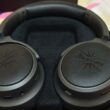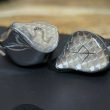Introduction
Yes, you read that right. They are fast, transparent, mids focused sounding IEM upon listening to them for the first time. But with everything else, they also comes with a little caveat. More on that throughout this article. Tanchjim have been hitting hard with their impeccably tuned IEMs these past few years starting with the Oxygen. Recently they introduced the Tanya to fill in the budget segment and immediately that one gained its own fans. Now with the Ola, I can see that they’re trying to showcase their tuning expertise at a much pocket friendly price tag.
Packaging
It’s the waifu season and Tanchjim is not missing that train with the Ola. At least it’s different from the black packaging boxes that are getting quite mundane lately. Still, it’s a sleeved box where the actual box inside is grey in color with the Tanchjim logo and embossed geometrical pattern which shows that Tanchjim really do care about their product presentation. Included inside are 2 sets of wide bore and narrow bore eartips. It’d be a jackpot if Tanchjim included their aftermarket T-APB eartips along with the Ola since I found that it complements the sound signature of this IEM. Apart from that, there’s a storage pouch provided to store your IEM instead of a carry case, which is typical for IEMs in this price range.
On to the build of the Ola, they’re made of plastic shell with an aluminum face plate which made them very lightweight. There are however sharp edges on parts of the IEM in which with the rather radical shape of the Ola, might induce fitting issues for some. I myself prefer something a lot more contoured (as in universal-custom shells) where it can provide better insertion and seal. On that note, the seal is sub-par on the Ola (at least for my case). The cable supplied is OK to say the least, and it reminds me a lot of the Moondrop SSR’s stock cable but a bit more sticky to the hands. Apart from the design of the Ola, there’s honestly not much to complaint.

Functions & Specifications
-
Material: Plastic Shell with Aluminium Face Plate
-
Type: Over-Ear
-
Transducer Type: 1x Polymer Graphene DD
-
Sensitivity: 108dB SPL/1mW @ 1kHz
-
Impedance: 16ohms @ 1kHz
-
Frequency Response: 7Hz-45kHz
What’s In The Box
-
Tanchjim Ola
-
Wide Bore Eartips (S, M, L) x1, Narrow Bore Eartips (S, M, L) x1
-
Carry Pouch
Retail Price & Where To Get
Get Tanchjim Ola at Red Ape – Headphone Store for only RM179.00
Purchase Link :
Red Ape Headphone Store Shopee : https://invol.co/clavuj8
Sound & Tonality
The Tanchjim Ola possesses a somewhat Diffuse-field Neutral sound signature which accentuates more on the mids and higher frequency response. In my opinion, the vocal is forward, mind you. With that, the usual pros and cons associated with this kind of tuning still exists with the Ola but are presented in quite a different manner. Tonality wise is kind of a mixed bag between being bright-neutral and being cold. But my perception is leaning more towards the latter. Do note that I’m writing this review based on my pairing of the Ola with the Tanchjim T-APB (T300B) eartips since it helps to balance out the overall tonality of the Ola.
Source Used
XDuoo X2s > XDuoo XQ10 > Tanchjim Ola
FiiO M11Plus ESS > Topping NX7 > Tanchjim Ola
Win11 > iFi Micro iDSD Black Label > Tanchjim Ola
Songs Used
Bass
Sub-bass is rolled off, that’s a bummer for sure. But…considering that the Ola is tuned to have a very niche monitor-ish sound signature, it’s no surprise that the linear low end region is tight, clean and smooth. Only if it’s loathed with texture, this IEM would showcase a very competent technical prowess. Bass lacks the thump, impact and punch which makes them somewhat boring for most mainstream genres. Along with the lean bass presence, bass bleeds are not an issue here which is a very big plus (with caveats to the lower-mids, of course) if your playlist demands it. In short, they’re a bit lacking in terms of bass quantity but in terms of bass quality, they’re almost there.
Mids
Due to the lean bass region, the lower-mids are clean and a bit dry. It lacks the weight and grunt needed to provide a more natural listen. If that’s what you’re after, this is not it. Despite that, they’re well articulated and crystal clear to the point that it made the mids sound nasally, depending on tracks and artist. Yes they’re transparent sounding but this chase towards clarity is taking its toll on the tonality of the Ola. It’s just a bit too cold and somewhat thin (YMMV). Upper-mids can get hot, unnatural and they’re almost too shouty for some tracks. I said almost shouty, but they’re not. It’s not that simple. The only thing that I can sum up for the mids is that you can either be overwhelmed by the somewhat ‘hot’ mids presentation or be awed by the overall cleanliness of the Ola.
Highs
Lower-treble despite not having too significant of a sibilant issue, they’re somewhat peaky and on the edge of being harsh. Surprisingly, they’re far from metallic sounding but rather I would summarize it as just being cold. Treble is a bit hard to put to words as it sounds to be distant but instruments in this region are heard with good detail retrieval (especially when listening to live albums). It’s got enough shimmer and sparkle without being too overbearing but they’re somewhat distant sounding (???). Upper-treble lacks air and again, they sound distant. Sorry, no nuances here guys…they’re perceived as accurate and on point. In simple words, the treble is far from smooth, can be somewhat fatiguing and can be a little too much if you’re sensitive to treble response but with a little refinement, this would have a wonderful treble response.
Soundstage
Impressive!! Especially upon my first listen. The stage width on this IEM is superb. But despite having one of the widest sounding soundstage within this price bracket, the depth is nothing spectacular. Don’t get me wrong as this is fairly typical for IEMs that bears similar sound signature like the Ola and for the price, this is nitpicking. Height is another issue where the Ola seems to have limited stage height and this in turn made them sound somewhat congested on certain tracks. But finally at long last, now the original TinHifi T2 is having a serious challenge in this aspect.
Imaging & Separation
There’s one word to describe imaging on the Ola: sharp. Yes, don’t let the price tag fool you as the Ola can provide a very vivid and sharp imaging capability, almost similar to a slightly more expensive multi-BA IEMs eg; Dunu SA3. Separation will most likely come hand in hand with imaging and as you’ve might have guessed; it’s distinct. Listening to the Ola with most mainstream genres will make you realize how busy a modern track can be while at the same time not being overly clinical. It amazes me how a simple single-DD configured IEM this cheap could deliver such respectable technical ability.
Driveability
Easy peasy lemon squeezy. Being true to the spec sheet, I’ve found that they’re far from being demanding nor power hungry, which made them very suitable for portable usage (especially for those with limited source options) but they really do scale well with more powerful sources. More on this below as I’ll go through some of my personal equipment stash paired with the Ola.
Synergy
The Tanchjim Ola is not really what I’d call a versatile sound signature. I’ve found that they’re best paired with warm sources such as the Ifi Micro iDSD Black Label. Not only it helps to attenuate the somewhat cold sounding nature of the Ola, the soundstage also improved by quite a noticeable margin with better depth and height. With that said, you might want to steer away from pulling the trigger on the Ola if you already have clinical sounding sources (especially ESS based sources) unless you prefer the cold, dry, clinical sound signature.

Comparison
Moondrop SSR
Having similarly angular shaped shells, the fitting of the SSR is much more comfortable and they can be inserted deeper with no irritating sharp edges touching your ear. Honestly the overall tuning of the Ola reminds me of the SSR. But upon A/B-ing, the Ola is slightly colder in comparison. Despite both having a single-DD configuration, the Ola possess a significantly faster transient response and clarity while the SSR sounds ‘slower’ and ‘looser’. The SSR extends further in the sub-bass region with more textured bass region as compared to the smoother and linear bass of the Ola. Mids sound more neutral and natural with enough ‘warmth’ on the SSR despite being known to be the ‘shouty’ one on the upper end. Detail retrieval is audibly superior on the Ola. Upper mids glare is much prominent on the Ola while the SSR is smoother sounding in this region. They both have similar extension in the higher region but with perceivably better quality and detail retrieval on the Ola. Soundstage is wider on the Ola while the SSR is a touch taller with similar depth on both IEMs. For imaging and separation, the Ola takes the cake here, period. It’s that good.
HillAudio Mirage
The Mirage possess a W-shaped sound signature that’s rarely can be found in this price region. With the readily ear-conforming universal-custom styled shell, it’s definitely better than the Ola in fitting aspect. Sub-bass extends further and more pronounced on the Mirage. Bass is slightly ‘looser’ but punchier in which the slight bleed complements the lower-mids of the Mirage. Mids are similarly forward for both with the Ola edges the Mirage slightly in terms of detail retrieval. Now why did I chose the Mirage? Because apart from being similarly priced, all three IEMs have the same issue; ‘hot’ thin, cold upper-mids and they’re very friendly only to warm sources or you just simply prefer them to be ‘hot’. Treble is similarly metallic-ish and somewhat harsh for both the Mirage and the Ola with slightly better extension and articulation on the Ola. Soundstage is smaller on the Mirage but slightly more rounded in comparison to the width-oriented Ola. The Mirage do have a perceivably deeper soundstage but they’re similarly lacking in stage height. Last but not least, the Mirage is honestly a no match for the Ola when it comes to imaging and separation which is far more vivid and distinct.
For Who?
While the Ola is not tuned to be universally versatile with most genres, they’re actually competent when it comes to technicalities. It’s an IEM that provides a totally (impressive) different pace and soundstage despite the low asking price and that should give potential buyers an idea of what to expect from similar sound signature going up the tier. In my use case scenario, I’d pick the Ola any time as a beater for FPS gaming due to its respectable technical prowess.
Verdict & Stars
Setting new bars in the budget segment, Tanchjim is going to be giving a lot of other brands a run for their money. It’s great to see companies offering a product with a commendable technical ability at such budget prices. While the Ola is not the first one to be having such price:performance value, it is refreshing and will definitely provide more options to choose from for the budget conscious audiophiles.
I would rate this product a 3.5 over 5 stars.










